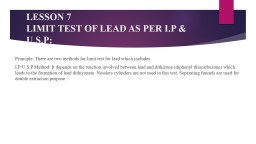

Principle There are two methods for limit test for lead which includes IPUSP Method It depends on the reaction involved between lead and dithizone diphenyl thiocarbazone which leads to the formation of lead ID: 1022137
Download Presentation The PPT/PDF document "LESSON 7 LIMIT TEST OF LEAD AS PER I.P &..." is the property of its rightful owner. Permission is granted to download and print the materials on this web site for personal, non-commercial use only, and to display it on your personal computer provided you do not modify the materials and that you retain all copyright notices contained in the materials. By downloading content from our website, you accept the terms of this agreement.
1. LESSON 7LIMIT TEST OF LEAD AS PER I.P & U.S.P:Principle: There are two methods for limit test for lead which includesI.P/U.S.P Method: It depends on the reaction involved between lead and dithizone (diphenyl thiocarbazone) which leads to the formation of lead dithizonate. Nesslers cylinders are not used in this test. Separating funnels are used for double extraction purpose
2. Dithizone forms green coloured solution of dithizone-chloroform extraction solution because dithizone is soluble in chloroform and this solution is used as a quantitative method for extraction of lead impurity from alkaline aqueous solution of test substance. The final product, lead dithizonate, in chloroform is red in colour and the mixture of lead dithizonate (red) and dithizone chloroform (green) forms a violet colour and the intensity of this violet colour produced in chloroform is compared with the standard solution .It should not be more than the standard solution
3. B.P. Method:In this method, lead salts are treated with sodium sulphide which results in formation of black precipitate of lead sulphide. However,even very dilute solution gives brown precipitate with sodium sulphide solution.Metals like copper and iron may interfere by producing black precipitate/brown colour by reacting with sodium sulphide. To overcome such problem, the test is carried out in the presence of NH3 and KCN which forms complex with cyanide and which further prevents the precipitation of copper and iron as sulphides
4. To conduct this test two solutions are prepared1.Primary solution(test): It contains definite amount of test substance2.Auxillary solution(standard): It contains very small amount of test sample and specified amount of standard lead solution, i.e. lead nitrate solution.NOTE: All reagents used in the preparation must be lead free and are designated as PbT reagents.
5. PROCEDURE:I.P/USP Method:TESTSTANDARD1A12g NH4Cl of the sample was taken in aseparating funnelDiluted standard lead solution equivalent toamount of lead permitted in the sample wasprepared and transferred to separating funnel2To it 6ml of ammonium citrate,2ml ofpotassium cyanide and 2ml of hydroxylaminehydrochloride was added , followed by 2drops of phenol red and the solution was made alkaline by ammoniaTo it 6ml of ammonium citrate,2ml ofpotassium cyanide and 2ml of hydroxylaminehydrochloride was added , followed by 2drops of phenol red and the solution was made alkaline by ammonia3Then it was extracted with 5ml portions ofdithizone solution(dithizone+chloroform) untilit becomes greenThen it was extracted with 5ml portions ofdithizone solution(dithizone+chloroform) untilit becomes green4This combined dithizone extract was shaken for 30sec with 30ml of 1%w/v nitric acid and chloroform layer was discardedThis combined dithizone extract was shaken for 30sec with 30ml of 1%w/v nitric acid and chloroform layer was discarded5To the remaining acid solution,5ml of standard dithizone was added along with 4ml of ammonium cyanideTo the remaining acid solution,5ml of standard dithizone was added along with 4ml of ammonium cyanide6Then the solution was shaken for 30 sec until colour producedThen the solution was shaken for 30 sec until colour produced
6. B.P Method:s.noPrimary(test)Auxillary1Ammonium chloride(test sample) of 2g was placed in nessler cylinderAmmonium chloride(test sample) of 2g was placed in nessler cylinder2Dissolved in hot distilled water containing 5ml of acetic acidDissolved in hot distilled water containing 5ml of acetic acid 5ml of acetic acid.To it 5ml of dilute lead solution was added.3Made alkaline with ammonia solutionMade alkaline with ammonia solution41ml of KCN was added1ml of KCN was added5intensity was comparedintensity was compared6Distilled water was added upto 50ml addedDistilled water was added upto 50ml added7Two drops of sodium sulphide solution was added and Stirred with glass rod and stand for 5 minTwo drops of sodium sulphide solution was added and Stirred with glass rod and stand for 5 min
7. The colour produced, by both the solutions, is compared. If the colour of the test is less than that of the standard, the limit test passes otherwise discarded.